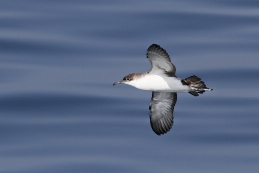30-01-2020
Mediterranean Shearwater: global project to protect an endangered seabird
Should the decline of Mediterranean Shearwater colonies keep their current rhythm, the reproductive population of this seabird could be reduced by more than 30% over the next fifty years. This seabird, mostly distributed over the western Mediterranean, is listed as vulnerable in the UICN Red list of endangered species (International Union for Conservation of Nature).
Promoting the study of biology and ecology of this marine bird for the first time at a global scale in the Mediterranean and improving its conservation in the ocean are the main objectives of the new project –led by the researcher Raül Ramos, from the Faculty of Biology and the Biodiversity Research Institute (IRBio) of the University of Barcelona.
Several institutions and entities take part in this new project on conservation and biodiversity –funded by the Swiss foundation MAVA. Among the participants are SEO/BirdLife, Island Biodiversity Research Initiative (IRBI), National Institute of Agronomy in Tunis (INAT), University of Oxford (United Kingdom), University of Crete and the Ionian University (Greece), and the Italian Institute for Environmental Protection and Research-ISPRA (Italy).
From the Balearic Sea to the Black Sea
The Mediterranean Shearwater (Puffinus yelkouan) is one of the most hurt birds due the impact of fishing activity, which catches more than 5,000 pelagic birds every year in the Mediterranean. Despite being an endemic species from the Mare Nostrum, this seabird from the order of the Procellariiformes was considered the same as the Balearic Shearwater (P. mauretanicus).
“We do not have a global knowledge on the Mediterranean Shearwater at the moment”, notes Raül Ramos, Ramón y Cajal researcher at the Department of Evolutionary Biology, Ecology and Environmental Sciences. “Today, there are sporadic studies that assess some aspects on the colonies and populations of this species, but in an isolated manner”.
Treating for the first time the study of the Mediterranean Shearwater at a metapopulational scale in the Mediterranean –specifically, in the regions of the Alboran Sea, the Strait of Sicily, and the Aegean Sea- is one of the most innovative parts of the new study. As part of the project, during 2020, the experts will study at the same time the space ecology (with miniaturised GPS) of five colonies of seabirds and will add data from previous studies to create a global evaluation gathering up to eight different populations in the Mediterranean.
The project will provide unpublished data to help define the main feeding areas for the Mediterranean Shearwater in the natural environment, the overlap between different populations, the nutrition pattern and areas of coincidence between fishing boats and seabirds. The study will assess the interactions between fisheries and seabirds that take place within the Network of Marine Protected Areas of Spain (NMPAs), a figure of protection of biodiversity in the oceanic ecosystems.
Moreover, the experts will apply geolocation technology to see the migration patterns and hibernation areas of these birds (estimated to be in the Black Sea) in order to shape the annual distribution of each population and the general biological cycle of this endangered species.
“With this global perspective, the conclusions from the new project will provide relevant scientific data for the knowledge and protection of this endangered species”, concludes Raül Ramos, member of the Research Group on Ecology of Marine Birds –led by Professor Jacob González Solís.

 Photo: Camil Albert
Photo: Camil Albert Photo: Pep Arcos, SEO/BirdLife
Photo: Pep Arcos, SEO/BirdLife With a global perspective, this is the first project to treat the study of the biology and ecology of several populations of this seabird, distributed along the Mediterranean Sea.
With a global perspective, this is the first project to treat the study of the biology and ecology of several populations of this seabird, distributed along the Mediterranean Sea. The conclusions from the new project will provide relevant scientific data for the knowledge and protection of this endangered species. Photo: Raül Ramos, UB-IRBio
The conclusions from the new project will provide relevant scientific data for the knowledge and protection of this endangered species. Photo: Raül Ramos, UB-IRBio